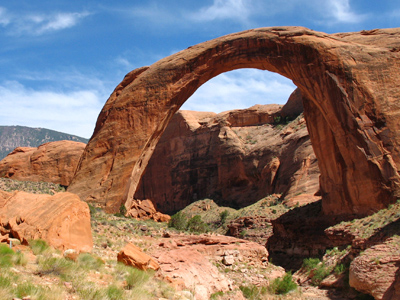On August 4, 2008, Wall Arch in Arches National Park collapsed. While the forces of gravity and erosion may contribute to the collapse of natural rock formations like Wall Arch, are there other forces that may hasten the collapse of magnificent natural rock structures?
Dr. Jeff Moore and his colleagues at the University of Utah, working with National Park Service scientists, looked at the structural dynamics of the iconic Rainbow Bridge and sought to determine whether anthropogenic energy sources were affecting its stability.
Rainbow Bridge, at 290 feet high and 275 feet wide, is one of the largest natural bridges in the world. It is a sacred site for five Native American nations: the Navajo, Hopi, San Juan, Southern Paiute, Kaibab Paiute, and White Mesa Ute. Located in southern Utah, Rainbow Bridge is managed as a national monument and is visited by 85,000 visitors from around the world each year.
It turns out that all rock structures vibrate in response to natural phenomena, like wave action from the ocean and atmospheric phenomena, like wind. Sometimes, a structure may be subjected to a vibration that causes its own vibrations to be amplified, a phenomenon called resonance. Moore and his colleagues used four seismic sensors to determine what the vibrational modes were for Rainbow Bridge, and to determine what types of vibrations would cause resonance in the bridge. Two seismometers were placed on Rainbow Bridge, one was placed on an adjoining rock 25 meters away, and one was placed on the canyon bottom, 220 meters away.
They discovered something amazing—Rainbow Bridge vibrates in 8 ways, called vibrational modes. These include vibrating up and down, side to side, and in a twisting motion. The seismometers were also able to detect vibrations caused by waves in Lake Powell, a man-made reservoir, as well as the vibrations caused by a man-made earthquake in Oklahoma, more than 1,000 miles away.
Conclusions

NPS
These findings demonstrated that the seismic energy generated by Lake Powell, and by a distant earthquake can excite resonance in Rainbow Bridge. The resulting small vibrations from wave activity at Lake Powell maintain the fundamental mode vibration of Rainbow Bridge at a higher level than it would have been had Lake Powell not been there. While the effects of this on the bridge are not now known, Moore et al. hypothesize that sustained microseismic vibrations could contribute to fatigue of critically stressed cracks, and that high magnitude vibration events, such as the earthquake, could cause damage to the bridge.
For More Information
Original article:
Moore, J. R., M. S. Thorne, K. D. Koper, J. R. Wood, K. Goddard, R. Burlacu, S. Doyle, E. Stanfield, and B. White (2016), Anthropogenic sources stimulate resonance of a natural rock bridge, Geophys. Res. Lett., 43, 9669–9676, doi:10.1002/2016GL070088.
University of Utah press release: Resonance in Rainbow Bridge
National Park Service Report: Rainbow Bridge Vibration Risk Assessment NPS/RABR/NRR - 2018/1617

This project was funded by the National Science Foundation, and by the National Park Service through the Colorado Plateau Cooperative Ecosystems Studies Unit (http://nau.edu/cefns/forestry/cpcesu/).
Prepared by Jean Palumbo, Southern Colorado Plateau Network Inventory and Monitoring Program, 2016.
Last updated: December 2, 2019
